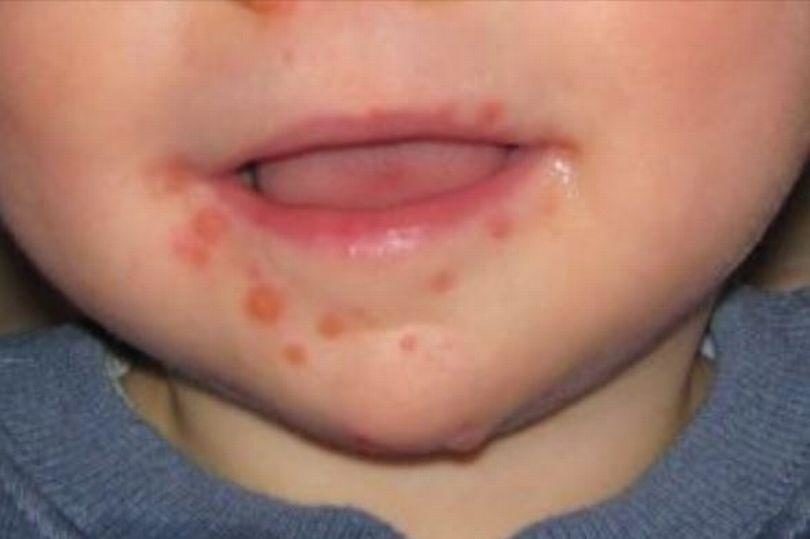Several pre-schools in Somerset say they've seen an increase in the number of cases.
Hand, foot and mouth disease is an infection caused by a virus and begins with a high temperature, loss of appetite, a cough and a sore throat and mouth.
Around two days later red, flat, discoloured bumps appear on the hands, feel, inside the mouth and sometimes the bum.
These spots can start to blister.
Painful ulcers can also develop, which can put kids off eating and drinking.
As it's caused by a virus antibiotics can't treat the condition.
You should keep kids at home until the symptoms clear, making sure they're drinking plenty of fluids.
According to the NHS you should give young children and babies smaller, more frequent feeds to keep them hydrated.
Medications like paracetamol can help ease the pain and bring down their fever.
Dr Nick Phin, deputy director of the National Infection Service for Public Health England, said: "Hand, foot and mouth disease is a mild viral illness that mostly affects children.
"The infection can cause a sore throat, high temperature and loss of appetite, as well as mouth ulcers and a rash after a few days.
"The infection normally clears up by itself in seven to 10 days. Keeping hydrated, eating soft foods, and taking age-appropriate doses of paracetamol or ibuprofen will help relieve your child's symptoms.
"To stop hand, foot and mouth disease from spreading further, practice good hand hygiene and keep your child off school until they get better."
What is hand, foot and mouth disease and who is vulnerable?
Hand-foot-and-mouth disease, or HFMD as it is better known, is caused by a virus.
Symptoms include:Anyone can get the disease, but children under age 10 are most likely to catch it.
- high temperature
- loss of appetite
- coughing
- stomach pain
- ulcers or sores inside or around the mouth
- a rash or blisters on the hands, feet, legs, or buttocks
These viruses can spread from person-to-person through direct contact with unwashed hands or surfaces contaminated with bacteria.
Medical attention is not usually needed unless:Cases have also been reported in popular Spanish holiday spot, Majorca.
- Your child is unable or unwilling to drink fluids
- Your child has signs of dehydration
- Your child develops fits, confusion or weakness.
- The symptoms are getting worse or have not improved after seven to 10 days.
Several British kids have contracted the disease, with one pair of twins left with the "worst case" doctors had ever seen.
Nine-month-old twins, Mila-Rose and Kyson, became covered in painful and contagious red sores during a week-long break in Majorca last month.
The family flew to Spain on September 19 and first noticed symptoms of the illness in the twins three days later.
After being cleared to fly, they returned home a week later where her GP told Kimberley that the twins had the worst case of the disease they had ever seen.
The illness is highly contagious, so can be easily spread from child to child once they are ill.
If your child stops eating and drinking, shows signs of dehydration, is unusually tired, is under three months and has a temperature of over 38 degrees you should see your GP.
You should also seek medical help if the rash develops pus or hasn't disappeared in seven to 10 days.




Comment: It would appear that unusual contagions and sickness are on the rise these days: More British tourists fall ill: 7 year old fights for life after food poisoning in Egypt, 8 guests at Italian wedding struck with mystery illness See also:
- New Light on the Black Death: The Viral and Cosmic Connection
- New Light on the Black Death: The Cosmic Connection
More on the spread of hand, foot and mouth:- Family confined to their hotel room for six days after kids come down with hand, foot and mouth disease (2017)
- Florida State University plagued by outbreak of hand, foot and mouth disease (2016)
- Canadian warship on NATO mission suffers outbreak of hand, foot and mouth disease (2016)
- New Strain of Hand, Foot and Mouth Virus Worries Parents, Pediatricians (2012)
- Incurable Mystery Hand, Foot and Mouth Virus Kills 19 Vietnamese Children to Date (2012)
Also check out SOTT radio's: The Health & Wellness Show: Syphilitic Superpower: The rise of STDs